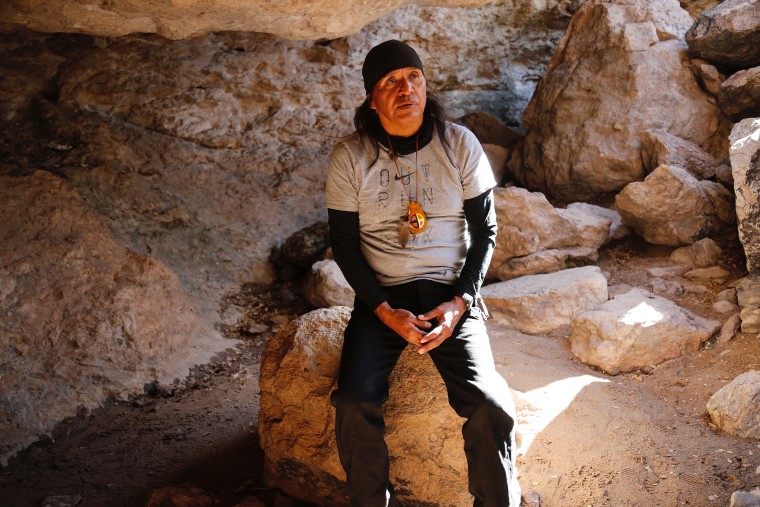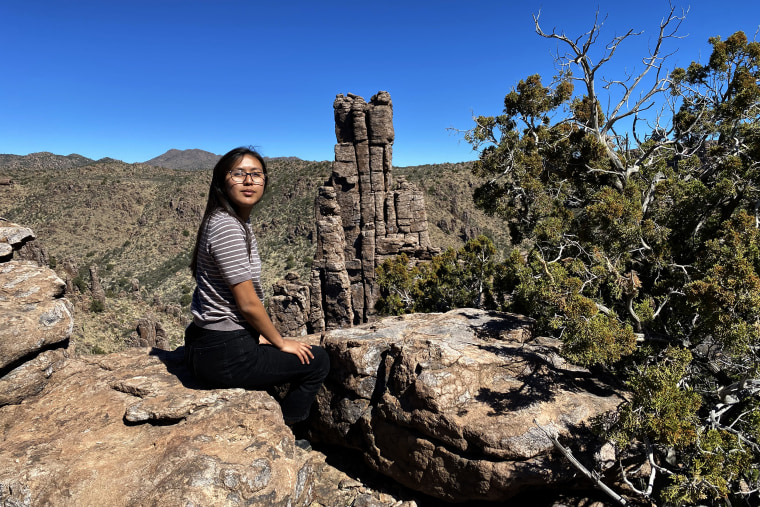AP TO UNMUTE
Tribal members in Arizona are fighting to protect a piece of land they consider their “Mount Sinai.”
March 3, 2021, 5:18 PM +04 By Christine Romo, Cynthia McFadden, Kit Ramgopal and Rich Schapiro NBC News
blob:https://www.nbcnews.com/c6fbf06c-337c-4d92-9ca4-c5f1846db995
SUPERIOR, Ariz. – The rugged patch of land known as Oak Flat sits in the Tonto National Forest. To the San Carlos Apache Tribe, the 740-acre swath of oak groves and sheer cliffs is sacred ground, a place where they have gone for centuries to hold religious ceremonies and communicate with the Creator.
“No different than Mount Sinai,” said Wendsler Nosie Sr., former chairman of the San Carlos Apache.
But Oak Flat is on a path to destruction.
The land is scheduled to be transferred to Resolution Copper, a company controlled by two foreign mining giants, and turned into one of the largest copper mines in the country. The transfer was set in motion by an eleventh-hour provision slipped into a 2014 defense bill by Arizona’s two Republican senators at the time.
The poverty-stricken San Carlos Apache Tribe is fighting back in court, alleging the land belongs to the tribe and holds special religious significance. But even they worry the path to victory is slim. Resolution Copper has poured $2 billion into the project and has had the U.S. government on its side.
The dispute has turned into a David-vs.-Goliath-style standoff, drawing in environmental groups and reviving centuries-old questions over land rights involving American Indians.

“We’re still trying to defend who we are,” said Nosie, who has been camped out at Oak Flat for more than a year as part of his mission to stop the mine.
He sees the conflict as the latest skirmish in his tribe’s long fight to maintain its ancient way of life.
The San Carlos Apache reservation, about 130 miles east of Phoenix, is among the poorest in the country. Four of every 5 families with children live below the federal poverty line, and the unemployment rate is 30 percent, according to a University of Arizona study.
The reservation is on the outskirts of Tonto National Forest, which is named for the Tonto band of Apaches who lived in the area until the U.S. Army cavalry forcibly removed them in the 1870s.
Many Apaches became prisoners of war. An untold number refused to surrender and instead jumped to their deaths at a ridge now known as Apache Leap.
The Oak Flat area has been considered a holy place for thousands of years, the home of spiritual beings known as Ga’an. Apaches go there to pray, to seek personal cleansing and to hold ceremonies that connect them to their ancestors. It is also a popular campground and hiking destination.
But Oak Flat has long been prized by mining companies. Beneath its surface lies a fortune — one of the largest copper deposits in the world.
Oak Flat has been protected under federal law since 1955, when President Dwight D. Eisenhower decreed the area off-limits to mining. President Richard Nixon’s Interior Department renewed the ban in 1971, but it added a loophole that allowed for the area to be mined if it was traded to private interests.
A bill proposing to trade away the land had repeatedly failed to pass both houses of Congress since it was first introduced in 2005.
But in December 2014, Sens. John McCain and Jeff Flake of Arizona slipped a last-minute rider into a must-pass defense spending bill. The move amounted to a bonanza for Resolution Copper, which is jointly owned by two mining titans — the Rio Tinto Group of the U.K. and BHP Billiton Ltd. of Australia.

The bill transferred 2,400 acres of national forestland, including Oak Flat, to Resolution in exchange for 5,300 acres of private land owned by the mining company.
Flake declined an interview request. McCain, who died in 2018, touted the project in a 2014 op-ed in The Arizona Republic, saying that the mine would generate jobs and boost the local economy and that the land would remain open to tribal members and others until the company breaks ground.
The legislation stunned and saddened Naelyn Pike, a San Carlos Apache tribal member who first testified before Congress in opposition to the arrangement when she was 13.
“Our cultural identity is being stripped away from us,” said Pike, 21, who is Nosie’s granddaughter.
“No tree can live without its roots,” she said. “And we’re that tree.”
Engineer Vicky Peacey, senior manager of permits and approvals for Resolution Cooper, said that the company is sensitive to the tribal members’ concerns and that it has already modified its mining plans to leave Apache Leap and hundreds of other special areas untouched.
Peacey said company officials have set up a tribal monitoring program, with dozens of trained monitors from several tribes working alongside archaeologists to identify features of the landscape that hold special meaning. “Every plant, every animal, water feature, rocks,” Peacey said. “It’s really helped shape our mining plan.”
Peacey emphasized that the project would employ about 1,500 people and pump about a billion dollars into the economy every year. She also said copper is critical to combating climate change.
Copper is in high demand in the U.S. and around the world, as it is an essential component in such green energy technologies as wind turbines, solar panels and electric cars. The mine beneath Oak Flat is projected to satisfy 25 percent of U.S. demand.
“We have to find a way to balance jobs, economic benefits in these rural communities, as well as environmental protection and cultural heritage preservation,” Peacey said. “I think we can do it in this project.”
The mining company plans to extract the copper using a method known as block caving, which over time will cause the ground to collapse and create a pit that the company acknowledges will be nearly 2 miles long and 1,000 feet deep. Oak Flat, along with its petroglyph-covered walls and Apache burial sites, is set to be swallowed up in a crater deep enough to hold the Eiffel Tower.
The project has the support of many who live in the area, including the mayor of nearby Superior.
“We need for this project to move forward,” Mayor Mila Besich said, citing its economic benefits.